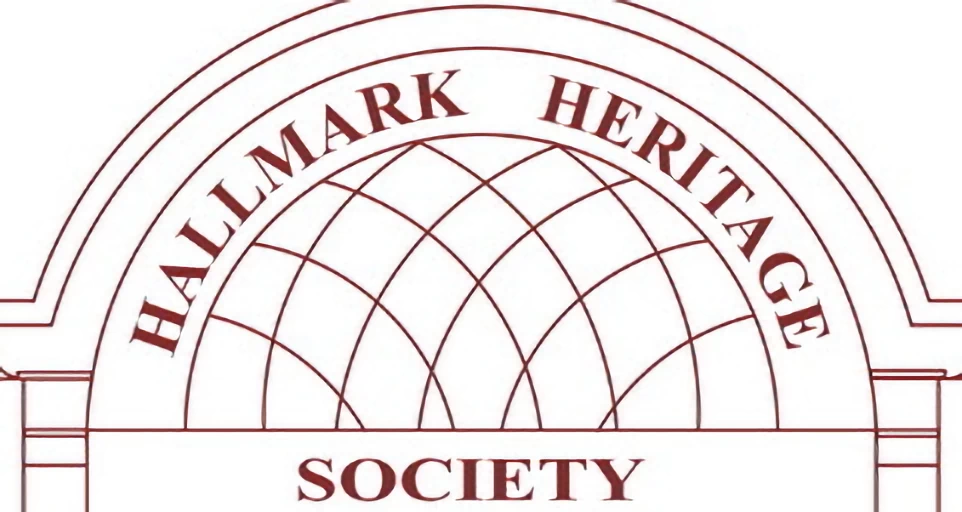Daily Colonist. Wednesday, July 24, 1907. LINK
VICTORIA IS VISITED BY THE MOST DISASTROUS FIRE IN CITY’S HISTORY.
Property Loss is $200,000 – The Number of Buildings Destroyed is Seventy-Five– Water Pressure Was Very Poor.
Swift and sudden, with no warning, and like lightning out of a clear sky, one of the most serious conflagrations in the history of Victoria, broke out yesterday afternoon about 2:30 o’clock and raged for four hours, fiercely leaping in its course across entire blocks of buildings, and was only brought under control when damage, estimated at $200,000, had been done, scores of families had been rendered homeless and a portion of the city had been entirely blotted out.
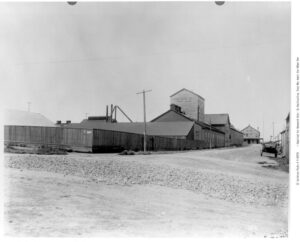
The fire had its origin on Store Street between Herald and Chatham streets in either Fisher’s blacksmith shop or a small building adjoining the boiler house of the Albion Iron Works.
It was confined between Herald and Chatham streets until it reached Quadra Street four blocks to the east, except in two places. One when it ravaged a number of houses on the south side of Harold Street between Douglas and Blanshard, and a second when it leaped across Chatham Street near the corner of Store and did some little damage to the buildings on the north side of that thoroughfare.
Jumping three blocks, it broke out again east of Quadra and north of Chatham Street on Green Street, a little avenue running east from Quadra to Pembroke Street
The fire had three stages, one, when commencing at 2:30 o’clock, it blotted out the block between Store, Chatham, Government and Herald, with the exception of four small houses on the South side of Chatham near Store; a second when about 3:30 o’clock it had reached Calvary Baptist Church, near the corner of Harold and Douglas near Blanshard street and a third, which had its origin almost simultaneously with the second when it destroyed eight residences on Green Street
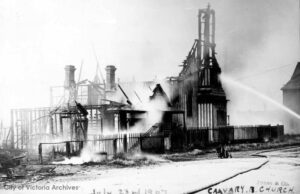
The firemen were practically helpless. With a pressure of water that was practically nil, they were unable to make but little headway against the flames which fanned by a strong breeze from the south west by a trifle west, devoured the frame buildings, dry as tinder from the drought of the past few weeks it was only checked in its eastward progress in two places. One was on Pioneer Street (continuation of Herald north of Blanshard) when five cottages were torn down and a brick house, that of James Townsley, intervened, and again when at the end of Green street there was nothing but meadowland.
At about 5:00 the attempts to combat the flames in the lower levels were abandoned and the firemen concentrated their efforts in the neighborhood of Blanshard street
At 4:00 in the afternoon in response to a telephone message from Mayor Morley, thirty men from the Work Point Barracks in charge of Lieutenant Vien arrived on the scene and did sterling service.
Practically the whole of the City Council were present and with Mayor Morley took active part in the task of firefighting.
Before the fire had been in progress an hour the mayor was deluged with offers of assistance for the sufferers. C. F. Todd was the first with a contribution of $500.
STORY OF THE FIRE
How it Started and Spread Eastward- Many Strange Freaks
The fire is supposed to have started in a disused boiler shop belonging to the Albion Iron Works at the back of Fisher’s blacksmith shop near the corner of Store and Harold streets. The first alarm was rung in about 2:30 PM and did not at first attract much attention. But there was a strong southeasterly wind blowing, everything was tinder dry, and the volume of smoke speedily attracted a crowd of anxious onlookers.
Fisher’s blacksmith shop was soon a mass of flames, and the situation rapidly became ominous. But the lack of water pressure soon defeated the best efforts of the Victoria fire brigade. The doomed building was adjoined on the east by three small frame buildings and next to these again was the old Indian mission church, all a ready prey to the devouring flames.
No effort was made to save any of these structures, and indeed for quite a while but one stream of water was available. All efforts were concentrated in an effort to save an old soap factory now used as a Chinese laundry, which from its close proximity to Government street appeared to be the point of danger. There were many who, perhaps not realizing the difficulty of fighting a dangerous conflagration without water, afterwards criticized the fireman for not having destroyed the mission church, but none then realized the possible extent of the catastrophe, and the efforts of the firemen were certainly applauded. But certain it is that shingles from the unchecked fire which first started in the spire of the Indian church were blown up street and were the direct cause of the disastrous uptown fire.
The ground between Herald and Chatham streets is, or was, largely occupied by small frame dwellings little better than shacks, and the flames spread northwards among these with frightening rapidity, and, with a high wind blowing it soon became evident that a conflagration was inevitable. Lower Chatham street is occupied exclusively by cribs and there were many painful scenes among the terror-stricken denizens. Women in scanty attire fled into the streets imploring aid, which was cheerfully rendered, though it turned out to be of no avail. Their furniture was piled out on the roadside and for a while seemed to be in safety, but the devouring flames spread across the street and eventually their entire effects were consumed despite all efforts to stop it the fire literally licked up everything in the block as far east as Government street.
The efforts of the firemen here deserve special mention. As long as the last hope remained, and even afterwards, they stuck to their work, and when the heat became too great, behind the shelter of a door the little stream of water was kept playing on the doomed buildings.
A pathetic incident was noted here. One of the ruined members of the tenderloin narrated to the bystanders that she had been burned out in San Francisco, and that this second visitation by fire was undoubtedly a visitation of Providence, and, amid heart-broken sobs, which left no doubt of her sincerity, declared her intention of hereafter leading an upright life.
Meanwhile the old soap factory, adjoining Mellor’s blacksmith shop on Government Street, was wrapped in flames, but the inhabitants had timely warning. Mr. Mellor had early removed his various implements to a place of safety, while the Chinese had also been busy, the sight of a Chinese woman bearing various strange instruments devoted apparently to the mysteries of Mongolian cookery, aroused general comment.
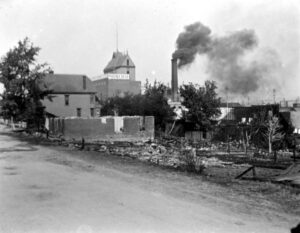
The flames spread across the street. First the grass took fire, thence the palings were ignited, and the fire spread to the heaps of old boxes and lumber stored on the vacant corner lot. And here one of yesterday’s many miracles was recorded. The cottages on the north side of Herald Street, east of Government, were untouched, although the houses to the back of them on the south side of Chatham street were all consumed, as were the houses from St. John’s church east on the opposite side of the next block in the same Herald street.
But this is not the history of the fire. It is rather the account of many fires, though having a common origin. The roof of some houses were watched, others were not; the wind displayed strange freaks and it was not uncommon to see one side of a block in flames while the other seemed immune.
The fire started about 2:30 and at 3:30 all electric power was turned off. St. John’s church, all unnoticed, burst into a blaze soon after three; but it was not until after four that the fire reached the south side of Chatham street, above Government. It started with the little hardware store on the corner and wiped out everything on the south side of the block. But the frame of the new building on the northeast corner of Government and Chatham next the brewery was untouched, as were the buildings of the lower half of the block adjoining. All the houses on the east half were destroyed, notwithstanding the unusual efforts to save them. Thus, almost the entire block bounded by Store, Herald, Chatham and Government streets, and most of the block immediately to the east are to-day a desolate waste with only a chimney standing here and there to mark the site of former human habitations.
THE FIRE SREADS
Flames Leap to St. John’s Schoolroom and Eat Up Adjacent Buildings
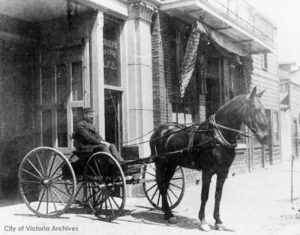
At 3:30 o’clock a spark ignited the roof of the St. John’s church schoolroom building, corner of Douglas and Herald streets, and in a few moments the structure was a mass of flames, with the heavy wind blowing, it was apparent to all the spectators that this was but the beginning of the conflagration – and so it proved. The row of two-storey tenement houses adjacent to St. John’s schoolroom speedily were aflame, and destruction spread across the street to the pretty Calvary Baptist church, which also was consumed in its entirety. Rapidly then the buildings to the north of the Baptist church caught afire and almost in the twinkling of an eye they became a prey to the flames. In the interior the fire had spread to Green street, decimating a large residential section in that portion of the city. The flames spared two houses facing Chatham street in a most remarkable fashion. There was a fire to the right of them and fires to the left of them, but happily they were out of range and escaped the heat to an extent which enabled dampened roofs to triumph.
GREEN STREET LOSSES
Fire Jumped Several Blocks and is Stopped by Open Space.
While the forces of the city firefighters were centered around the Calvary Baptist church, yet another fire full four blocks to the northeast had broken out. It was on Green street, the little thoroughfare which leads from Quadra street to the yet unopened Pembroke street, that the most easterly limit to the ravages of the flames was set.
Passing by whole blocks of houses on Quadra street and the intervening avenues, the flying embers kindled the roof of the residence of J. Mellhuish. Like tinder the dry framed building burned. Long tongues of flame licked out across the burning building and the domicile of Frederick Garnham. Thence the wind veering some ways more to the south, drove the smoke and cinders across the street to the houses belonging to John Thompson, on the northerly side of the avenue.
Swiftly consuming all before it the fire passed on. In succession it passed into dwellings occupied by James Salt, T. Brown, and J. Keown and leaving nothing but a trail of ashes, brick chimneys rampant showing where on each of their two stories the grates of the various rooms were located, and general desolation. It was checked at the end of the avenue by meadowland.
FIRE IS CONQUERED
Soldiers and Firemen Succeeded in Subduing the Flames.
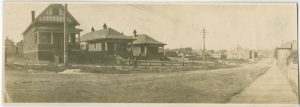
The conflagration was finally collared at Pioneer street It had marched resistlessly as far as Blanshard street and there paused, sending out two advance couriers of destruction. One travelled northeast up Green street, laying waste a dozen of small homes until its advance was stayed by the open fields. The other lighted on a house about half a block up on the north side of Pioneer, and here the struggle began. There was practically no water. The famous Deluge engine stood useless at the hydrant without enough water to keep her boiler going. Nor were the other engines in better case, while the chemicals had to go very far afield for water.
But Victoria had had enough. Pluck and brawn can do at a pinch without water and it mastered the fire yesterday afternoon. The soldiers from the Esquimalt garrison, Commanded by Lieut. Vien, were there and there were hundreds of willing Victorians. They, with the help of the fire brigade, sufficed.
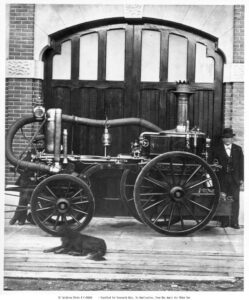
The blazing house was clearly doomed, as was the adjoining cottage. But No. 22 presented the possibility of an effectual gap. Headed by the soldiers men rushed in with axes and ropes and the dainty home was doon demolished. But even this was soon seen to be too little. The flames, fanned by a strong wind, raged with unabated fury, sparks and shingles flew blazing near and far and it was evident that further sacrifices were necessary.
The call was nobly responded to and the houses were desperately attacked. Despite the intense heat the neighboring buildings were partly demolished with axes and the pulled down by ropes. One young man in particular, whose name could not be learned, mounted the tottering roofs and at imminent risk to himself attached the ropes. Dozens of men manned the ropes and pulling together at the word of command, dragged down the tottering roofs and shaky walls amid the cheers of the spectators who thronged the streets.
All the houses in the vicinity were crowned with watchers armed with buckets and axes on the look out for errant sparks, thus defeating the skirmishers of the fire fiend. Others were on the watch for embers, and one instance came under notice which undoubtedly prevented a fresh conflagration.
A burning shingle, unnoticed save by two men lighted by an outhouse adjoining a stable about a block from the fire. The place was surrounded by residences and danger was imminent. Fortunately the men mentioned arrived and extinguished the flames just as they were beginning to get a hold, a a fresh catastrophe was unquestionably averted. The incident is typical. There were scores of such. Victoria’s citizens saved Victoria yesterday.
It was not until 6:30 pm that nay pressure could be obtained on Pioneer street, and with its advent all serious danger vanished.
WITH CHIEF WATSON
Many Aspects of Conflagration Seen From Motor Car

In a scarlet car, begrimed almost beyond recognition, Fire Chief Watson was hurried from point to point by Joe Watcher, who before he got the red Oldsmobile was himself a fireman. It was from the motor that rushed between flame-lined streets, with burning embers sweeping overhead and heat-laden breezes blistering the sides, that the fire chief directed the almost futile fight against the breeze-born fire. Now whirling to a Merryweather pumping under a full head of steam to drive what slim pressure was available from a Store street hydrant to lines of hose on Herald street, then back to a chemical that had emptied its tanks of soda and acid in a vain effort where wooden frame buildings were sweeping away in serried sheets of fire, and, after ordering the chemical back to refill hurried from point to point fighting with all the resourcefulness he was capable of with the scant water the pumps could give him.
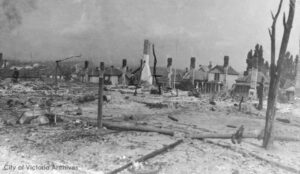
Many were the scenes viewed from the scarlet Oldsmobile in that ride with the fire chief. At Green street, where James Smith’s house was blazing and the roof of the Stelly residence was flaring red close by, while showers of sparks which were to carry fire to six other houses destroyed on this street, the fire chief rushed from the car to prevent a hysterical woman from rushing into the flames, and nearby a box containing valuables was dragged through the window of a burning building within a few minutes before the place collapsed.
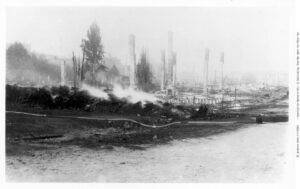
By the roadsides piles of household furniture lined the way, and pathetic indeed were the scenes viewed. Men, women and children, rushed out from buildings, already burning, with arms laden with furniture. One woman rushed out with a canary in a cage and after forcing the cage into the hands of a stranger rushed back again – and the woman received the cage carried it about, all unconscious of the identity of the owner . Far removed from the fire zone, too, members of households dragged their goods from the houses, men called upon their neighbors to aid them shift pianos, and other articles of value. Men rushed about seeking express wagons, vainly endeavoring to divert wagons hurrying to answer to other equally urgent calls; every conceivable vehicle was commandeered, buggies for which horses were not available were impressed, loaded with goods and drawn away to places of safety by men and boys who toiled between the thills instead of the horses. A wagon hauling a load of earth was found, his load quickly dumped out and furniture laden instead.
From Chinatown to Quadra street men and women sat guarding bundles and plies of furniture, trunks heaped by the roadside, Chinamen had everything from basket loads of chickens to opium pipes, bundles rolled in matting, and all their worldly goods, upon which they say, impassioned as stone buddhas, waiting. In fields beyond the fire’s reach little girls sat crying beside the family sewing machine, watching the piano, and what wares dragged hurriedly from their homes that had reached safety. At a street corner a woman sat on a trunk, wringing her hands, crying because of the things the fire had licked up.
Many, indeed were the scenes observed from the red car of the fire chief.
When the alarm brought the department to the scene the fire was in the disused boiler shop of the old Albion iron works, spreading before a southwest breeze to the frame shacks of Herald street, running to the Mission church, beyond which was an open space, the burned area left from the destruction of Song Kee’s cabins that the health department burned many months ago. There the chief and his firefighters were at work when word came of the blaze on Green street. Flying sparks borne on the breeze, had fired the shingle roofs of the street lying five blocks away. Leaving Assistant Fire Chief McDowell in charge on Herald street the chief hurried to Green street. The wooden buildings, mostly one and a half storey frame structures were burning briskly, and without much water the firemen found work difficult. The occupants were rushing their furniture to the open lots some distance away, and until driven away by the flames the salvage was continued.
A shout of one of the buildings brought the firemen to where a woman, hysterical and crying loudly, refused to come out, shouting that her valuables were being burned. She insisted upon going back, although the stairs had been burned , and the roof was about to collapse with its supports burned away. Finally a fireman threw his arms about her, and dragged the woman shrieking from the burning building.
“Oh save my tin box,” shouted a woman, who tugged at the arm of the fire chief.
Following her lead the chief hurried to a story and half house on the south side of Green street where he strode upstairs three at a time and in a back bedroom grasped a tin box from beneath the bed, as per direction.

The woman hurried away with the tin box and was last seen seated beside it in the fields a hundred yards away, with a few of her household goods beside her.
The scarlet car was hurried to Pioneer street, where several frame buildings had taken fire. By this time the fire had crossed Government street, where now the telegraph poles are askew and the cross pieces like yards cock-billed on a sailing ship in mourning, and on the south side of Chatham street the terrace was flaring, with ribwork of the block showing in a red sea. From this place a shower of sparks, lifted on the wind blew northward and eastward, the flying embers igniting the shingles of roofs in many places. Above Blanshard, where the fire was travelling rapidly up from Street John’s church schoolroom, licking up the residences, from which only piles of furniture were dragged, only to be consumed by the roadside. There the old engine, the Deluge, was at work, pumping streams that had far less force than the firemen would have desired.
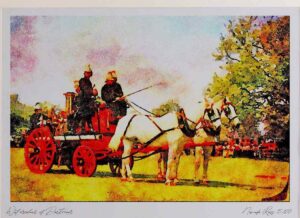
On Store street was the John Grant, a Merryweather, and at Blanshard, the Deluge, while another Merryweather was out of commission at the firehall. From one to the other, thence to chemical wagons that were scattered here and there and from there to hose wagons, the scarlet runner that carried the chief was rapidly driven by Mr. Wachter, and, despite the disadvantages under which he labored the chief worked the apparatus and staff at his disposal to good advantage.
To the auto, as it stood at the corner of Blanshard and Chatham streets, awaiting the chief, watching a new connection being made to further the fight against the spreading fire, came excited men who offered many times the usual price to have furniture hauled to places of safety, and then hurried back to drag more of their wares to the roadside. Other men ran with messages of other fires, and from one place to the other scorched the red motor. On his way from Victoria West to the fire the Chief’s buggy had been put out of action, he having been thrown from the rig and dragged some distance, his thigh and leg being injured. The motor anyhow was better than the buggy would have been, by far. Auto-chemicals would also have been more useful; they would have refilled and returned in much quicker time.
From the streets to the west, down the hill, a pall blurred the summer sky, and flying embers were seen hurtling high. As the red car of the chief swung down the hill to these areas only broken chimneys were seen amid piles of burned ashes where squares of burned buildings had stood. In one place an unfortunate dog was heard shrieking; it had got in the field of hot ashes and after jumping in agony with burning feet it collapsed and would have roasted had not a bystander rushed in and dragged the animal out. To Store street the auto hurried and the Merryweather was at 5:15 p.m. ordered to the cistern and the corner of Quadra and North Park streets, but there was too little draught there to be successfully use this and the nearby hydrant was utilised.
While the chief stood watching the engine being connected an auto arrived with considerable dynamite brought from Work Point.
“The dynamites here, chief,” shouted the driver of the car.
“What dynamite?” queried the fire chief. “I don’t want any dynamite.”
The explosives were sent back. The scene of the climax was on Pioneer street halfway between Blanshard and Quadra, a force of engineers and gunners from the Work Point garrison under Lieut. Vien, with several policemen and a host of willing volunteers recruited from the spectators, aided the firemen. While several streams of water played on the wooden buildings that were burning nearby Constable Heather and some of the engineers, now engaged as sappers, clambered to the ridge tree of the building adjoining, and, while a host of workers with pick and axe demolished the lower part of the building they fastened ropes to the building. Pulling up these a hundred or more strained lustily tearing down the building piece by piece, until it finally clattered down in a cloud of dust, and as the firemen brought the fire in the buildings nearby under control the fight was won.
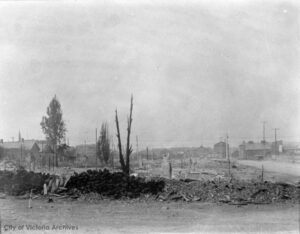
Away rushed the chief’s car then to investigate other districts, and chemical after chemical was sent to douse out danger spots. It was a desolated area through which the chief now patrolled, several blocks being swept bare to the four sides, with only chimneys standing like monuments to mark the ruin.
“Did you hear of the fire spreading from Beacon Hill?” asked one excited bystander at 7 p.m., and in consequence of this report the red car was driven to Beacon Hill only to find a large area of burned grass to mark where a fire had occurred.
Thence the chief hurried back to the fire hall, where gangs were arranged for night work, and, without a whimper the men who had worked all afternoon went out again to work all night to drown out smouldering places and to patrol watching lest any fire break out afresh.
Some woodpiles, notably a large pile on Chatham street near Douglas burned all night, with water playing upon it by tired firemen.
But they did not murmur, not a bit. Other than the chief, injured by a fall from his buggy on the way from Victoria West, and several bruised and cut arms and legs, none reported serious injuries.
EXCITED HOUSEHOLDERS.
Hundreds of Cottage Owners Make Frantic Attempts to Save Goods.
Chief amongst the spectacular incidents of the fire were the frantic endeavors of the occupants of houses on the line of fire to save their belongings. Soon as the fire got beyond control panic seized the watchful crowd, who, with buckets and blankets worked like trojans to stay the on sweeping flames. All the drays and express wagons in the city were soon impressed into service and the automobiles were not lacking in endeavors to salve movable property. Vacant lots in the immediate vicinity of the doomed houses were speedily converted into a rendezvous for all sorts of movable belongings, hundreds of willing hands being ready for the work of rescue. Very few thefts were reported, the police maintaining remarkably good order amongst the excited crowds.
WATER PRESSURE.
Best Service Given according to the Facilities of the Mains.
Water Commissioner James L. Raymur asked by the Colonist last evening to say something as to the water service during the fire. Mr. Raymur said that as soon as the fire was seen to be assuming alarming proportions the pumps were started working at their full capacity. Supt. Of Waterworks Pence and three assistants started turning the valves so as to give the maximum pressure in the fire area. So soon, however, as the fire reached Blanshard street, the waterworks department, figuratively speaking, “threw up its hands” as, with no mains running north and southeast of that section, they were powerless to give additional pressure. Everything, said Mr. Raymur, had been done by his department to assist in fighting the fire, and he assured the reporter that the entire available service was worked to its limit during the progress of the conflagration.
MAYOR’S STATEMENT.
Special Council Meeting to Deal with Water Shortages.
Before leaving for home last night Mayor Morley took such steps as the occasion seemed to require for the relief of sufferers by the fire. A subscription list was opened, the first contribution being C.F. Todd’s $500 donation elsewhere referred to, and other measures of immediate relief were also taken.
Instructions were given to the chief of police to provide meals for those in need at the expense of the city and also to fit up the city market building and the spare rooms in the jail to provide sleeping accommodation for those sufferers who should be unable to find other quarters.
The inadequacy of the water supply having been painfully emphasized by yesterday’s events, the mayor informed the Colonist last night that he intends to call a special meeting of the city council this week to consider and adopt the best means of remedying it.
SOME OF THE LOSSES.
Partial List of Those Whose Property Was Destroyed.
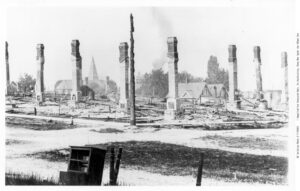
In all over seventy houses were destroyed. Another twenty were partially damaged. In scores of other instances the occupants commenced removing their furniture and much of it was damaged. The following is a partial list of the total losses.
Herald street, between Store and Government:
City Lot 469, Corner of Store and Herald, one storey building, city assessment $500.
City lot 470, One storey building, city assessment $400.
City lot 471, Albion Iron works boiler shop, city assessment $400.
City lot 472, J.W. Meldrum and J.G. Meldrum, one storey building, city assessment $650
City lot 473, Methodist mission, Herald street, two storey hall, city assessment $1000.
City lot 476, Mary Bowker, one storey building, city assessment $600.
City lot 477, Joseph Bros., one storey building, city assessment $250.
Chatham street, between Store and Government.
City lot 479, Lee Chong and Lee Way, one storey house, $1600.
City lot 480, B.C. Land and Investment Co., one storey house $1000
City lot 481, D.B. Lenevue, one storey house, $1000
City lot 482, D.B. Lenevue, one storey house, $1000
City lot 483, J.W. and G.D. Meldrum, one storey house $300
On this street three houses, belonging to L. Reda, escaped almost miraculously. Standing next to the extreme western end of Chatham street in the centre where the fire started, the flames did not touch them, though houses across the street on the north side of Chatham suffered.
Herald street, between Government and Douglas streets:
City lot 622, H.E. Levy, one storey house, city assessment $600.
City lot 623, H.e. Levy, one storey house, city assessment $600
City lot 624, Kam Jow, Lee Dow, Lee Kow, two storey house, city assessment $1200
The residence of Mrs. Hastings, although surrounded by burning buildings, escaped unscathed.
Chatham street, between Government and Douglas streets:
City lot 637, corner of Chatham and Government street, east side, Tom Yue and Tom Duck, two storey house, city assessment $2400.
City lot 636, Peter Levell, two storey house, $1300
City lot 635, H.E. Levy, two storey house, city assessment $2000
City lot 634, H.E. Levy, two storey house, city assessment $2000
City lot 633, J. Cotsford, two story house, city assessment $200
City lot 632, F. Fraser, two storey house, city assessment $1250
Herald street between Douglas and Blanshard, north side.
City lot 715, Mary H. Garland, two one storey houses, city assessment $2200
City lot 718, Calvary Baptist Church, $15,000
Between Douglas and Blanshard, south side.
City lot 710, Street John’s church school house, $1500
City lot 708, Mrs. G.P. roberts, two storey house, $2400
City lot 707, R. Porter, One storey house, $1000
City lot 706, Clara Pelletier, two storey house, $2000
City lot 705, Clara Pelletier, two storey house, $2400
City lot 703, T.F. Geiger, two storey house, $1700
Chatham street or Caledonia avenue between Douglas and Blanshard
City lot 723, Mrs. J.W. Williams, 2 storey house, $1600
City lot 724, Mrs. J.W. Williams, 2 storey house, $800
City lot 725, Mrs. J.W. Williams, 2 storey house, $1200
City lot 726, Mrs. J.W. Williams, 2 storey house, $1200
Two houses belonging to H. Miller on Caledonia avenue between Douglas and Blanshard streets had an almost miraculous escape. Despite the fact that sparks and embers in dense clouds were falling thickly upon the roofing the two buildings did not catch fire. Men were placed on the roof with wet blankets and buckets of water who quenched the embers as soon as they landed. On Pioneer between Blanshard and Quadra the following residents were turned out:
Street number 18, D.T. Barnhardt, $1200
Street number 20, Mrs. Alice Etherliegh, $1400
Street number 22. George Kellor, $1200
Street number 26, Henry Burton, $1400
Street Number 28, George R. Greenwood, $100
Street Number 30, Michael Keappock, $1000
Street Number 32, William Ward, $1600
On Green street the losses were south side:
James Smith, 2 storey houses occupied by Smith and Williams late of san francisco, valued at $2500. Insured for $1500.
McAllister, J., occupied by Methuish and garnham, valued at $3200
Wallenstein, one house, occupied by Keown, valued at $1400
Green street, north side:
John Thompson, 2 houses, occupied by Thompson and Hennen, $2400
Brown of Brown and Cooper, house and stable, $1800. Salt house, $1200.
FIRE NOTES
Dr. R.L. fraser was busy in the fire area attending to some of his patients. Hacks were kept at the doors of some of those confined to their beds in the vicinity of the fir, in readiness to transfer them to hospitals if need arose.
Chief Langley of the city police was given the use of the Lieut,-Governor’s auto. He summoned his entire force by ten quick strokes on the fire bell, the signal arranged for emergencies, and the police gave assistance to the firemen.
The British Columbia Electric Company was forced temporarily to shut off their power yesterday on account of the fire. During the evening arrangements were made to serve customers, and they have had men at work all night and announce that this morning they will be in a position to deliver power as usual.
.
